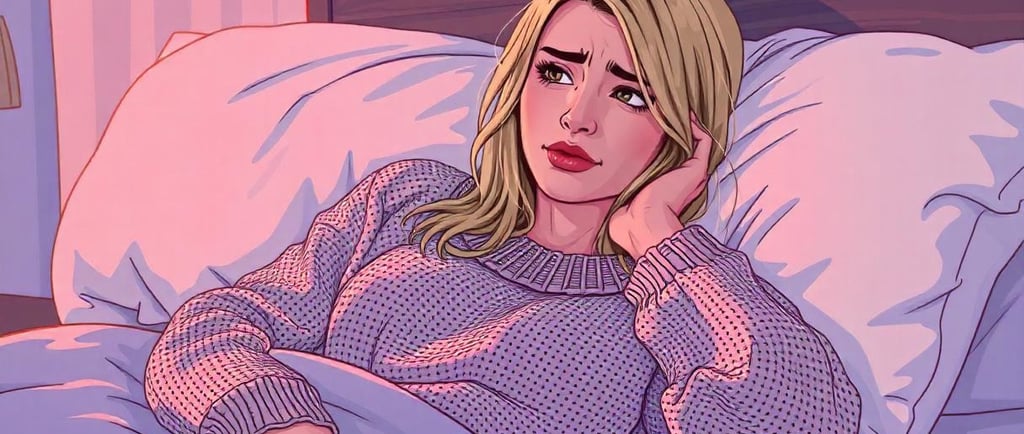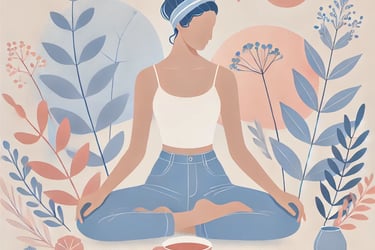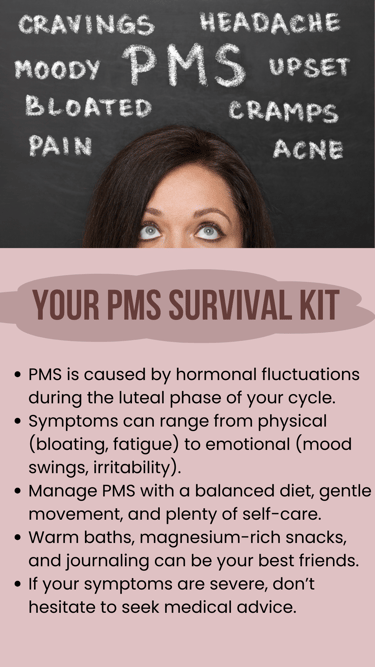Why PMS Is More Than Just Mood Swings (And How to Feel Better)
HEALTHWELLNESS


Let’s set the scene: You’re in your favorite sweatpants (the ones that should probably have been washed last week), binge-watching something you’ve already seen three times, when suddenly, you find yourself tearing up because the characters hugged. Five minutes later, you’re mad at your partner for breathing too loudly, and then you’re in the kitchen contemplating eating an entire jar of Nutella with a spoon. Sound familiar? Congratulations, you’re likely in the throes of PMS.
So, what is PMS anyway? Premenstrual Syndrome (PMS) is that delightful cocktail of physical, emotional, and behavioral symptoms that many people experience in the days leading up to their period. Thanks to hormonal fluctuations, PMS symptoms can range from mild to “I’m moving to the woods to live alone forever.” And no, it’s not just in your head—it’s a very real biological process that impacts up to 75% of menstruating people. Let’s dive into why it happens, how to manage it, and why crying over a cookie commercial is perfectly valid.
What Is PMS?
PMS, or Premenstrual Syndrome, occurs during the luteal phase of the menstrual cycle—the days between ovulation and your period. During this time, hormones like estrogen and progesterone do a little dance (and by dance, I mean they plummet and throw your body into chaos). This hormonal fluctuation is the root cause of PMS symptoms, which can include mood swings, bloating, fatigue, cravings, and irritability, among others.
For me, PMS feels like my brain has decided to install a fun house mirror in my emotional processing center. Things that wouldn’t normally bother me suddenly feel like the end of the world. And let’s not even talk about the bloating—why do my jeans feel like they’ve shrunk overnight? It’s maddening, but it’s also completely normal.
Why Does PMS Happen?
To understand why PMS happens, we need to talk hormones. Estrogen and progesterone are the stars of the show, and their levels fluctuate throughout your cycle. After ovulation, progesterone rises to prepare your body for a potential pregnancy. When pregnancy doesn’t occur, progesterone levels drop, and that hormonal shift triggers PMS symptoms.
But hormones aren’t the only players here. Factors like stress, diet, and sleep can amplify or ease symptoms. For example, ever notice how your PMS feels worse after a week of poor sleep or indulging in too much caffeine? That’s because your body thrives on balance (even if it doesn’t feel like it during PMS).
How to Manage PMS Like a Pro
The good news? You don’t have to suffer in silence. Managing PMS starts with understanding your body and giving it what it needs.
First, let’s talk food. While it’s tempting to give in to every craving (hello, carbs and chocolate), balancing your diet can make a big difference. Magnesium-rich foods like dark leafy greens, nuts, and dark chocolate (yes, chocolate!) can help ease cramps and mood swings. Bananas are also a great choice—they’re full of potassium, which can combat bloating. But hey, if that chocolate bar is calling your name, answer it. Sometimes, indulgence is self-care.
Movement can also work wonders. I know, the last thing you want to do when you’re bloated and cranky is exercise, but even gentle movement like yoga or a short walk can help. Exercise releases endorphins, which are like little mood-boosting warriors fighting off irritability.
Now, let’s talk self-care. When PMS strikes, I go into full-on cocoon mode: heating pad, cozy blanket, herbal tea, and a good book or Netflix marathon. Warm baths with Epsom salts are also heavenly—they ease muscle tension and give you an excuse to lock the bathroom door for an hour. Journaling can help, too. Sometimes, putting your feelings on paper is the best way to make sense of them (or at least vent about how unfair life feels when your favorite snacks are gone).
For more persistent symptoms, supplements like magnesium, vitamin B6, or evening primrose oil might help. But before you raid the supplement aisle, check with a healthcare provider to ensure they’re right for you.
The Emotional Rollercoaster of PMS
Let’s not gloss over the emotional side of PMS. Mood swings, heightened sensitivity, and irritability can leave you feeling like you’re starring in your own soap opera. One moment, you’re crying because your cat looks extra cute, and the next, you’re snapping at your partner for existing. It’s a lot.
But here’s the thing: your feelings are valid. PMS has a way of amplifying emotions that are already there, so if you’re feeling extra sensitive, it’s okay. The key is to give yourself grace. Take a few deep breaths, talk to someone who understands, or write it all out in your journal. And if all else fails, retreat to your cozy cocoon and remind yourself that this too shall pass.
When to Seek Help
For most people, PMS is manageable with lifestyle tweaks and self-care. But if your symptoms are severe—think debilitating cramps, extreme mood swings, or anything that significantly disrupts your life—you might be dealing with PMDD (Premenstrual Dysphoric Disorder), a more intense form of PMS. In that case, talking to a doctor is crucial. There’s no need to tough it out alone when help is available.
Round-Up: Your PMS Survival Kit
PMS is caused by hormonal fluctuations during the luteal phase of your cycle.
Symptoms can range from physical (bloating, fatigue) to emotional (mood swings, irritability).
Manage PMS with a balanced diet, gentle movement, and plenty of self-care.
Warm baths, magnesium-rich snacks, and journaling can be your best friends.
If your symptoms are severe, don’t hesitate to seek medical advice.
Conclusion: One Chocolate Bar at a Time
PMS is a wild ride, but you don’t have to let it take the wheel. By understanding your body and taking care of yourself, you can navigate this hormonal rollercoaster with a little more grace (and a lot of chocolate). Whether you’re powering through with yoga or binge-watching your favorite show under a blanket, remember this: you’re not alone, and you’re doing amazing.








Willow & Linen
Embrace slow living and create cozy moments.
let's stay in touch
© 2024. All rights reserved.
